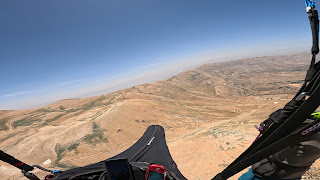Disclaimer:
Please note again… that tests will always differ with other sizes. At first, if flown with seatless harnesses, or must I say a completely different harness. Also if the same sizes are flown at different loads, lighter loads will get the weakest climb but will be penalized in control in heavy air or pushing through a heavy airmass. Bigger sizes have more gliding performance and also better climb in weak conditions. In my small tests, I always state the size, the total flying weight, and afterward IMHO, the optimum weight I found in that particular glider.
Ozone Buzz Z7
The Buzz Z7 is the low EN-B from OZONE. It has a 5.1 aspect ratio.
Test: Ozone Buzz Z 7 size MS 75-95 flown at 92 all up.
Harness: Woody Valley X-rated 6 size XL modified to fit my taste.
Test:
The Buzz Z7 holds a robust construction for daily use. You can see the details here: https://flyozone.com/paragliders/products/gliders/buzz-z7/
Launching the Buzz Z7 even in nil wind rises smoothly, and evenly. It is an easy glider for that low B class to inflate. However, I just remembered to mention that even to this date, and after thousands of hours, I still catch every opportunity to kite any glider anywhere, as kiting your glider and playing on the ground is a very important step to evolve. If you can master your glider in some turbulent landing spot, then you will master your glider in the air. Just because what your glider does in the ground, it will do the same in the air. If you can master it accurately and refine your feel under it, you will quickly evolve.
Now back to flying that cool Buzz Z7 is our strong Cedars range as the air is cooler and thermals are generous. I was also alternating with the Nova Ion 7 which is a low B, and I will also write a review shortly. The Buzz Z7 is a cool, easy comfortable EN-B. The movements are quite balanced and the pitch and roll are automatically controlled to stay at low angles above your head despite the rough conditions. It felt sometimes like a school glider behaves.
The brake pressure is moderate on that Buzz Z7 and not tiring at all for long flights. The handling is sweet, and the Buzz Z7 is an agile glide for that low category without being dynamic. The level of overall comfort is similar to the Buzz Z6, with a slightly more joyful ride.
The new hidden feature is yet to come!
The more experienced pilots who are flying the 2 liners Photon, know very well, why that glider flies so well. It is not that the number you see in calm air that matters. But rather the efficiency of sliding through that moving airmass and behaving like climbing stairs up, while moving forward. That’s the hidden efficiency and excellence behind the creations.
I am not telling you that the Buzz Z7 flies like the Photon!
Of course, I am not for sure.
I am just telling you that this R&D ‘know-how’ is integrated into the Buzz Z7. That low B with its low B characteristics felt to get the most of that moving airmass when you least apply the brakes and let it fly as much as your ability can…
It is definitely slower and cooler to enter, but it still enters and moves forward quite efficiently for that low B class!
The glide in moving air is impressive as it doesn’t bump into the airmass but rather slows but digs through smoothly without losing the glide.
To feel that feature on a low B is quite impressive.
The turning radius can be very narrowed for little thermals. The Buzz Z7 doesn’t really dive in turns. It is optimized to get flat turns, and it climbs beautifully well!
The speed bar has moderate pressure and can be used all the way when needed. The glide at speed is still very good. Even though there’s no B, C connection, I found that pulling the C risers could easily keep the glider overhead while on the bar.
Ears are super easy to induce, they reopen without pilot intervention.
Landing is super easy as the glider can be slowed down quite well.
Conclusion:
By creating the Buzz Z7, I think Ozone has given that low B a multi-functional task. While being very easy to handle and confidence-inspiring, they gave it an impressive performance package for that low B category, coupled with joyful and balanced handling. So young newcomers, or even senior pilots who are looking for a stress-free glider while preserving a good efficient level of gliding and climbing performance, should definitely try out the Buzz Z7.














